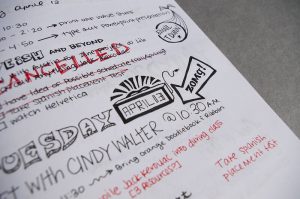Using Stephen Covey’s methodology with LeaderTask

“It’s important to prioritize.” This phrase is a leitmotif in most works on time management, penetrating deeper and deeper into the consciousness of everyone who seeks to master this science. Any specialist in the field of time management knows that wrongly defined priorities can bring to naught not only all efforts to organize and plan the working day, but also significantly complicate life in general. Except that “knowing” doesn’t always mean “being able to”. Simple awareness of this leading principle of time management is sometimes not enough to learn how to prioritize correctly, and people begin to ask themselves, “How do I know what’s really important?”.
Stephen Covey, a renowned expert on efficiency and internal resource management, has tried to help his readers understand this difficult topic with the books First Things First and Focus: Achieving Your Highest Priorities. In these works, the author describes his method of organizing time to achieve maximum efficiency and at the heart of his system is also based on the concept of priorities, which is not just involved in the process, but literally permeates every step on the path of improving self-organization. Stephen Covey in his books gives a detailed typology of existing priorities, offers the most successful systems of criteria, provides signs, features and examples of how to correctly define them.
Of course, Stephen Covey’s system is not limited to prioritization alone and includes a full range of techniques for effective planning. In order to apply this system more successfully in practice, it is worth using additional tools, such as electronic organizers. The most suitable choice is LeaderTask planner. This program was developed with consideration of the implementation of complex and multi-level time management systems and due to its flexibility and versatility will perfectly cope with the duties of an assistant in the process of planning things according to the methodology of Stephen Covey.
1. Destination formula
The key aspect of Stephen Covey’s system is the purpose formula. It determines all the subsequent features of the planning process, allows a person to identify the main directions of his activities, the goals he sets for himself and the functions to be performed for this purpose. In fact, the formula of purpose remotely resembles the mission of the enterprise, which sooner or later has to be formed by any businessman. According to Stephen Covey’s theory, the purpose formula is a description of the most important benchmarks and goals on your life path. It can be written in the form of a detailed list of principles or, on the contrary, in the form of a short and concise phrase. You can also write it on a piece of paper or in a text file. But you should take into account that Stephen Covey recommends that you review, analyze and evaluate your purpose formula on a weekly basis, so it is desirable to have it handy.
The “Notes” tool that LeaderTask organizer offers you is designed for such notes. By transferring your notes to the computer planner, you can be sure that your data will be safe and sound thanks to the backup function. And also you will always be able to quickly find the information you need. It is worth adding that the organizer has a wide range of text formatting options that will allow you to highlight key points, emphasize important notes or illustrate any note.
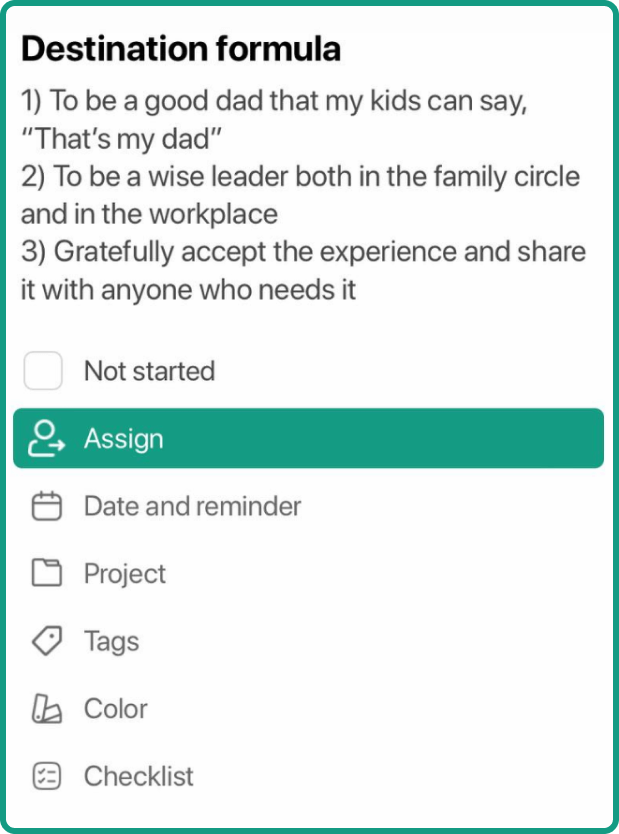
On the basis of the formed formula of purpose you can identify the main roles that you would like to fulfill in your life. Each role should have its own purpose. You can create a list of roles and their goals next to the purpose formula.
2. Roles
Organizing time according to Stephen Covey’s methodology suggests that any task written into the plan relates to a specific role, reflecting one area of your life.
In LeaderTask organizer it is easy to implement this by creating labels for each role in the navigator.
In doing so, Stephen Covey recommends forming contextual goals for roles that will answer the questions “What?”, “Why?” and “How?” you do while in a particular role.
Special attention should be paid to the role of “sharpening the saw”. It is mandatory for everyone and is a process of increasing your capabilities and abilities in various areas of your life, organized along its dimensions. Stephen Covey explains this role as follows: “We are often so busy ‘sawing’ (producing results) that we forget to ‘sharpen the saw’ (maintaining and enhancing our ability to produce results in the future).”
3. The four human needs
Stephen Covey believes that human life is lived in four dimensions: physical, social, intellectual and spiritual. These dimensions are respectively revealed in the following needs: to live, to love, to learn and to leave a mark.
Every role you fulfill in life exists in all four dimensions, which are intimately interconnected and generate powerful synergies.
In the planning process, you need to monitor and, most importantly, analyze the degree to which your needs are filled at each stage leading to the achievement of your goals. To bring these four life dimensions into the process of time organization you can use the “Projects” section in LeaderTask organizer. After creating the necessary elements, you will be able to assign each task to a certain type of need, which will allow you to quickly select only those that belong to the required dimension or their combination among the list of tasks.
4. Markers for tasks according to their priorities
The basis of Stephen Covey’s system is the Time Management Matrix. It reflects four basic levels of prioritization of tasks for a person in terms of urgency and importance.
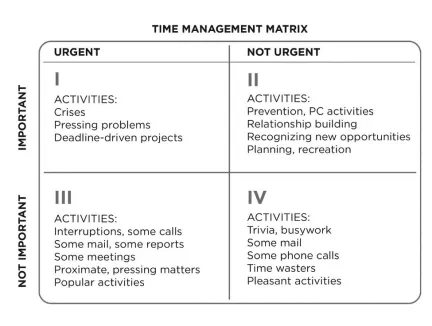
According to the author of the matrix, for successful and effective activity most of the tasks (65-80%) should be concentrated in Quadrant II. Only performing important but not urgent tasks will allow you to achieve the desired results and enjoy the process of realizing your life goals. Tasks from the other quadrants, in their turn, bring inconvenience and unpleasant feelings, introduce elements of chaos into your life plan and make you put off really important things for later.
At first glance, it may seem that only Quadrant II cases should be included in the plan and other priorities should be left out. But this can only be realistic under ideal conditions, when the human factor is removed from the equation of life. In reality, however, we interact with other people on a daily basis, struggle with our weaknesses, and fulfill our responsibilities, whatever they may be. Therefore, when planning your workday you need to consider all four quadrants and prioritize them honestly, first and foremost to yourself. In the future, this will allow you to analyze your affairs and determine your quadrant ratio.
To apply the Time Management Matrix in the LeaderTask organizer, there is a “Tags” guide. Here you can create elements corresponding to each of the quadrants and choose their design. Assigning tags to tasks will allow you not only to visually determine the degree of importance and urgency of tasks, but also to sort the list of tasks by priority level.
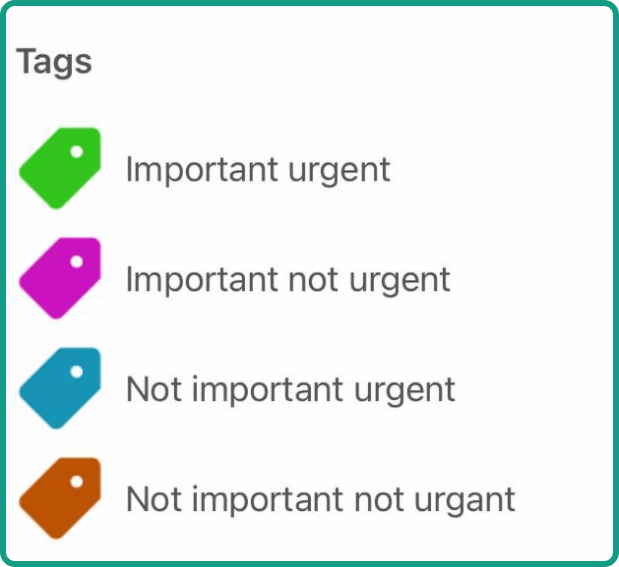
In addition to the basic prioritization system based on the Time Management Matrix, Stephen Covey recommends detailing the levels of importance of tasks using the ABC method, assigning a letter to each task. Thus, a task labeled with the letter A has the highest priority. The letter B means the average importance of the case. And C tasks are characterized by a low degree of importance or urgency. In a large flow of cases you can further detail the priority of cases by entering numerical designations: A1, A2, …, B1, B2, …, C1, C2, …, C1, C2, …
Using the ABC method or its extended variation in practical activities can be easily implemented with the LeaderTask organizer. To do this, you just need to add the required letter and number to the beginning of the task and the program will sort the tasks by importance. LeaderTask’s task sorting mechanism is ideally suited for implementing Stephen Covey’s priority system; tasks can be sorted by markers.
5. Decision-making framework
In his works, Stephen Covey repeatedly emphasizes that planning should begin with Quadrant II activities, i.e. important but not urgent activities that bear the juiciest fruit. To illustrate the process with this principle in mind, the author uses a favorite example of time management experts, the story of the hard fate of water, sand, pebbles and large stones. In this case, the big stones reflect the key matters corresponding to Quadrant II, and the small things characterize the other degrees of importance and urgency. The essence of the approach is that the first thing to do is to create a framework for the working day or week using the big and important task stones, and only then build the rest of the plan around them.
It is worth paying special attention to the process of setting deadlines, which is an inevitable companion of any planning system.
In LeaderTask organizer, you can define deadlines for tasks using several methods.
You can simply drag a task to the agenda area for the required period and it will be automatically assigned the corresponding date and time. The method of moving tasks in the agenda is suitable when you plan the next days quickly, as well as when you add pre-created tasks (e.g. from the “maybe” list) to the plan.
Or you can set the date and time of the task using the Deadline dialog box. This method is more convenient for precise planning, setting long deadlines or the frequency of task repetitions.
In addition, when planning the schedule of a particular day, you can filter the data by date using the Filter toolbar or the Mini Calendar. After that you just need to create a task by typing its name in the task tree and it will be automatically assigned the date by which the filtering was performed. This option is preferable for long-term planning.
Stephen Covey in his paper planner offers two zones for writing things down. The first zone is for tasks that have specific deadlines, and the second zone is for the current day’s priority list, i.e. tasks that should be done today when there is time for them.
LeaderTask organizer also provides such an opportunity to its users, which once again confirms the program’s compliance with Stephen Covey’s methodology. The list of current tasks that have not yet been assigned a specific time is located at the top of the calendar. In this electronic planner you can create long-term tasks that will take more than one day to complete. These tasks are also located above the timeline and are labeled with arrows to indicate that the deadline for the task extends beyond the current day.
As mentioned above, case planning should be implemented primarily based on the tasks from Quadrant II.
6. Weekly update
Concentrating on business and worries, you should never forget about rest, as it is a full-fledged component of any plan. That is why Stephen Covey recommends paying special attention to weekends as a logical continuation of the working week. At the same time, being in close connection with the weekdays, the weekends must necessarily be different, only under this condition will be the much-needed renewal. Of course, this does not mean that you should devote your weekends to Quadrant IV. It is enough to simply switch your activities to a different mode and engage in tasks from the same Quadrant II, but more suitable for the weekend atmosphere.
LeaderTask electronic planner also tries to take care of your updating. That is why weekends and non-working hours are highlighted with a different shade in the program, so that you can immediately determine that this area belongs to the sphere of rest and you need a different approach and things of a different nature.
Taking into account that work schedule can be quite individual LeaderTask organizer offers its users to define the duration of working hours and days of the week related to weekends by themselves in case of non-standard situations.
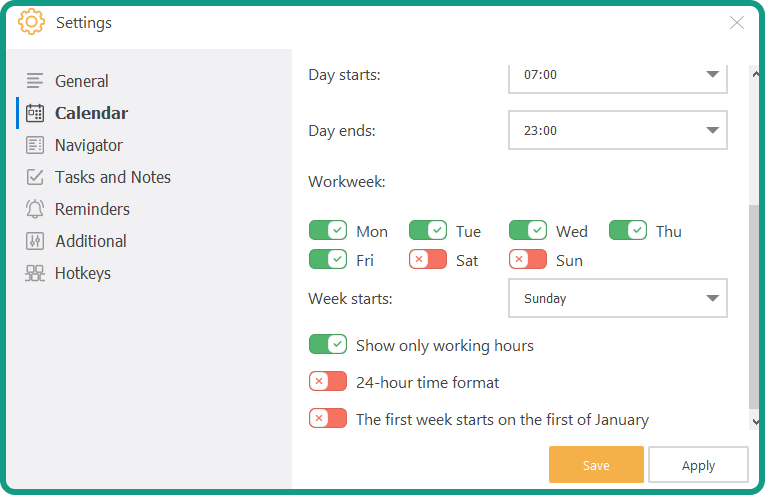
7. Scale of the week
Stephen Covey singles out the week as the most appropriate, even ideal, period of time. Suitable for everything. According to the author, a week is easy to plan, weekly performance is easy to analyze, regular weekly tasks give good results, but do not become a routine duty that burdens a person.
Thus, according to Stephen Covey’s methodology, a week is the key planning period, its basis. Using LeaderTask computer planner, you can easily perform weekly planning by switching to the appropriate calendar display mode.
This will result in a 7-day area displaying the days of the week from Monday through Sunday.
To make planning more comfortable, LeaderTask scheduler provides an option to expand the agenda area to the entire workspace using the buttons located on the border between the task tree and calendar. You can also hide the navigator in the View menu.
Working according to Stephen Covey’s system, you will often have to review the list of tasks planned for the current or next week. And when the list of tasks is large, there is a desire to get only the list of tasks related to a particular week, excluding everything irrelevant at the moment. This is why LeaderTask organizer provides an opportunity to filter tasks by certain time intervals. To do this, you need to select the days you need in the calendar.
Filtering by pre-created parameters is performed using the “Filter” toolbar.
8. Backup time zones
When telling his readers about the process of assigning tasks on a timeline, Stephen Covey notes that it is undesirable to make a clear second-by-second plan for the entire day. The author recommends leaving free time and focusing on the concept of creating a flexible plan. This will allow you to react faster and much more calmly to sudden crisis or urgent tasks, because such situations in most cases will not be able to significantly disrupt your plans and will probably fit into the “air” in the schedule reserved by you in advance. If critical events do not occur, you can always occupy the remaining time with useful things from Quadrant II.
Stephen Covey also introduces the concept of time zones for important tasks, which reserve time in the plan for one or another area of your life without detailing the tasks to be performed. Most often these are repetitive activities for which free time is reserved in advance. For example, playing sports three times a week. So, it can be a trip to the pool, and exercises in the gym, or maybe playing football with your child in the yard. In any case, it will be physical exercise and time should be reserved in advance.
To create a regular task in LeaderTask organizer, you need to use the familiar “Deadline” dialog box. Here, using flexible repetition settings, you can set the required frequency of the task.
It should be emphasized that when working according to Stephen Covey’s system, you will have to refer to the frequency of tasks more than once. The author recommends weekly analyzing, evaluating and revising your activities and the basic elements of planning, such as the purpose formula, roles and goals. In addition, you should make it a habit to make a weekly plan for the following week and adjust it daily according to your current circumstances. It is better to determine the time for these activities in advance and reserve it with the help of a periodic task. When exactly to conduct weekly planning, on Friday at the end of the working day or on Sunday before the upcoming work week, Stephen Covey suggests that you choose for yourself, but the fact that this planning is necessary and, most importantly, effective leaves no doubt.
It is worth noting that the type of periodic tasks also includes most of the things you do as a “sharpening saw”. These are educational tasks, updating procedures, physical exercises, in general, anything that allows you to maintain and increase your inner resources to reach new heights.
9. Symbols
In the audio version of the seminar “Focus. In the audio version of the seminar “Focus” the listener is introduced to the subtleties of working with the current plan with the help of special designations, the list of which is given in the FranklinCovey paper organizer. For example, to indicate that a case is in progress and to quickly find the latest work project after a forced shift of focus, you need to put a dot next to the task. A tick marks a completed case. An arrow sign means that the task is postponed, and a cross means that it is canceled.
The list of standard preset statuses in LeaderTask electronic organizer fully corresponds to this list of characters.
In addition to the above statuses, Stephen Covey’s methodology suggests using a certain sign (a circle) to indicate delegated tasks that have been assigned to another person, but have not yet been completed and are waiting for feedback. In LeaderTask organizer you can see the statuses of both your own tasks and delegated tasks.
Another auxiliary sign can be a task label for the “maybe” list. The tasks on this list are not even goals, not deeds, but just ideas. They may never be realized, but they may become a key element of your life, so you can’t put it on the to-do list, but you don’t want to lose it in your memory either. Stephen Covey recommends immediately assigning tasks on the “maybe” list to a specific role. To distinguish such an idea from the to-do list, you should assign a “maybe” label to it. Tags are defined in the corresponding handbook and can be attached to tasks.
10. Four dimensions of the role
As it was written above, each role is realized in all four needs: to live, to love, to learn and to leave a mark. At the same time, these dimensions are closely related to each other and can overlap or overlap. This relationship is reflected in LeaderTask organizer due to the possibility of multiple assignment of tags and projects, as well as due to the distribution of these concepts in different sections. Thus, you can assign several roles and projects to one task at the same time. In the future, this feature will allow you to build the necessary task lists more precisely and correctly using the filtering tool. Thus, one task can refer to the roles of saw sharpening, student and teacher simultaneously reflecting both spiritual and intellectual dimensions.
11. Filtration
In his writings, Stephen Covey devotes much of his attention to the importance of balance between roles and between the dimensions of life. Only if you achieve balance in all the important areas of your activities will you be able to achieve success. All aspects, phenomena, aspirations and goals are closely linked. So, if the role of “Leader” is realized and the role of “Father” is neglected, you will not receive a positive response from your own self and you will not be able to say with a light heart that your life is perfect. Stephen Covey emphasizes the “and” conjunction between roles. This applies to the balance of needs as well.
The corresponding logic is embedded in the filtering algorithm that LeaderTask organizer is equipped with. In addition, the flexible toolkit allows you to create complex, multi-criteria queries to get detailed task lists.
For example, you can use the Filter toolbar to generate a to-do list related only to the “maybe” list for a specific role, or consider important tasks related only to job roles and their physical dimension.
12. Four gifts
Stephen Covey writes that there are four abilities in response to four human needs: self-awareness, conscience, creative imagination, and independent will. Working with these gifts depends to a large extent on you and your inner disposition. But even here LeaderTask electronic organizer can become useful and help you realize the ways of their development.
Thus, one of the ways to interact with self-awareness Stephen Covey calls keeping a personal diary, which you can organize as a note in the LeaderTask scheduler. The ability to automatically insert the date will greatly facilitate the process of filling out the diary.
The development of conscience is based on reading relevant literature. This does not include specialized publications on your profession. These should be “wise” books that can make you think about important philosophical phenomena in your life. Nevertheless, you should also read books for education, and you should structure your library. The “Projects” section in LeaderTask organizer is convenient for this purpose. Here you should also create an “Information” project, which will contain all the information required for each role. Thanks to the ability to assign projects and several labels, you will be able to find the necessary information for any of the roles in a few clicks.
13. Key Notes
To record useful information about tasks, Stephen Covey recommends a detailed and fairly sophisticated note-taking system that allows you to find the information you need relatively quickly in a paper organizer.
With the development of computer technology, the need for manual page turning is becoming more and more rare, and search functions and capabilities are becoming wider and more diverse.
Stephen Covey is an excellent expert in the field of time organization. His methodology has allowed many people to improve and even radically change their lives. Using the system of this guru of internal resource management and implementing it with LeaderTask organizer, you too can qualitatively increase the level of your self-organization and achieve high efficiency and harmony in your life.



